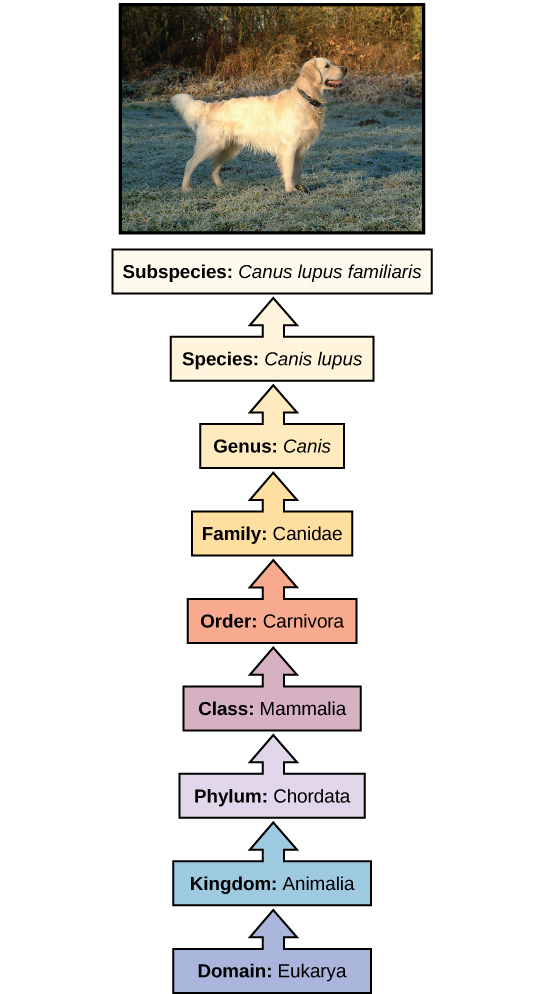7 Biosystematics
7.1 Taxonomy
Taxonomy
Dr V Malathi
The scientific study of taxonomy involves naming and categorizing species according to their evolutionary ties and common traits. Taxonomy offers a universal framework for recognizing, examining, and comprehending the diversity of life by arranging life forms into an ordered system. The foundation of the system can be found in the work of Carolus Linnaeus, who created a system for classifying species in the 18th century.
Levels of Taxonomic Classification
In taxonomy, organisms are categorized using a hierarchical structure that progresses from general to more specialized categories. From highest (most inclusive) to lowest (most specific), the conventional rankings are as follows:
- Domain: : This is the highest level of classification, which divides life into three major groups namely: Eukarya, Bacteria, and Archaea.
- Kingdom: This is the next level of classification which divides life into major groups like Animalia (animals), Plantae (plants), Fungi, Protista, and Monera (for bacteria).
- Phylum (for animals) or Division (for plants): In this level the organisms are classified according to their main body plans or structural characteristics.
- Class: This is an additional division within phyla, such as the phylum Chordata’s Mammalia (mammals).
- Order: Groups related families; for instance, Carnivora includes families of carnivorous mammals.
- Family: Assembles families that are connected to one another; for example, the Carnivora family includes families of carnivorous mammals , Felidae, the family of cats etc.,
- Genus: In this level of classification species that are very similar are grouped together ,for example, Panthera includes large cats like lions, tigers, and leopards.
- Species: This is the most specific level of classification. In this level organisms that can interbreed and produce fertile offspring are grouped together. The species name is always italicized and consists of the genus name followed by the specific epithet (e.g., Panthera leo for lions).

” The taxonomic classification system” by modification of work by Janneke Vreugdenhil is licensed under CC BY 4.0
Binomial Nomenclature

“Carolus Linnaeus “ by Hendrik Hollander, via Wikimedia Commons is in the Public Domain, CC0
This is system of naming organisms with two name . This system of naming was popularized by Carolus Linnaeus.
This Linnaeus’s binomial (two-name) system is the standard format for naming species. In this system each organism is given a Latin name consisting of:
- Genus: Always capitalized.
- Species epithet: Always lowercase.
The binomial name is This two-part name is universally recognized enabling scientists worldwide to identify species without language barriers. Example Homo sapiens, is the binomial system of naming of humans .
Taxonomy of Humans
Domain: Eukaryota
Kingdom: Animalia
Phylum: Chordata
Subphylum: Vertebrata
Class: Humania
Order: Humaniformes
Family: Humanidae
Genus: Homo
Taxon: Homo sapiens
Watch the video from Fuse School to know How Are Organisms Classified?
Types of Taxonomy
- Classical or Linnaean Taxonomy: Traditional classification based on physical attributes and observable qualities is known as classical or Linnaean taxonomy.
- Phylogenetic or Cladistic Taxonomy:Using branching diagrams known as phylogenetic trees or cladograms, phylogenetic or cladistic taxonomy groups species according to their genetic links and evolutionary lineage.
- Numerical Taxonomy: Numerical taxonomy assigns weights or scores to shared traits in order to evaluate how similar organisms are to one another.
- Molecular Taxonomy: This classification system uses genetic studies, such as DNA sequencing, to identify links between organisms that are not readily apparent from morphological characteristics.
Importance of Taxonomy
- Organizational Structure: Offers a framework for biological study and aids in the organization of a large number of species.
- Evolutionary Understanding:Evolutionary understanding demonstrates the interconnectedness of life on Earth by revealing the relationships and evolutionary histories of organisms.
- Conservation: Identifies species and highlights hotspots for biodiversity and endangered species to support conservation efforts.
- Communication: Makes it possible for scientists across the world to successfully communicate about organisms by enabling uniform and universal naming.
The study of taxonomy is dynamic and ever-evolving, allowing us to classify and understand the diversity of life. It provides information about the natural world through organized classification, assisting disciplines from agriculture and medicine to ecology and conservation.
Test your understanding

